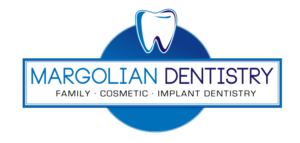When you think of Botox, you probably imagine it is used to treat facial wrinkles. Botox to relax the appearance of fine lines is popular, but it can also be used in other ways, including therapeutically.
At Margolian Dentistry, we can utilize Botox to treat patients diagnosed with TMJ disorder.
What Is TMJ Disorder?
Temporomandibular joint dysfunction (TMJ disorder) is a condition that affects your jaw joints. These joints, your temporomandibular joints, hinge your lower jaw to your skull. It is also called TMD.
When these joints operate correctly, they allow you to move your lower jaw comfortably and smoothly from side to side and up and down. These movements allow you to eat, talk, laugh and yawn without discomfort.
If your jaw joints become inflamed and tender, it can mean moving your jaw is uncomfortable or painful, and the range of movement is limited.
What Are the Signs of TMJ Disorder?
Typical signs of TMJ disorder in Oshawa can include:
- Jaw pain.
- Difficulty opening or closing your mouth.
- A clicking or popping sound when you try to open your jaw.
- Facial pain can extend into your neck and shoulders.
- Tinnitus.
- Earache.
- Toothache.
- Headaches and migraines.
What Can Cause TMD?
Causes of TMJ disorder include jaw injuries, general wear and tear, arthritis, and often teeth grinding and clenching, a condition called bruxism.
Clenching and Grinding Can Damage Your Teeth and Jaws
Habits like bruxism can cause tremendous damage to your teeth and jaws. When you clench and grind your teeth, it can wear them down excessively and cause them to become chipped and broken. You may notice your teeth look shorter than before or that the incisal or biting edges are thinner as they become worn.
Other signs include noticing changes to the way your teeth bite together. Your teeth may become looser or splay outward due to the pressure created when you clench and grind.
Extreme muscle contractions can cause these excessive clenching and grinding forces in your jaws. When this is the case, Botox injections can help.
How Can Botox Treat TMJ Disorder?
Botox works by helping to relax the muscles that cause clenching and grinding. It blocks nerve signals that cause these unwanted muscle movements, reducing muscle contractions.
Our dentists are skilled in using Botox in Whitby. We only use minimal amounts to achieve maximum results. There is no need to worry as you can still move your jaws properly, but the pain and tenderness should decrease two or three weeks after your injections.
How Long Will Botox Last?
A therapeutic Botox treatment in Ajax can last anywhere from 6 to 9 months before the effects begin to diminish. You can top up the results. It’s not unusual to find that repeat treatments are less necessary over time or are no longer required.
Getting a Diagnosis and Treatment for TMD
If you have noticed your jaws feel painful in the morning or that you keep on waking up with chronic headaches, contact us so we can carry out a proper dental exam.
Our dentists will examine your teeth and jaws gently. We may wish to take diagnostic images to assess the condition of your jaw joints more closely. Once we have this information, we can devise an appropriate treatment plan to alleviate your symptoms.
Botox is just one treatment we may recommend. TMD can sometimes be caused by several factors producing a range of symptoms. We may wish to collaborate with other health practitioners like a physiotherapist or chiropractor to help provide a better treatment outcome.


